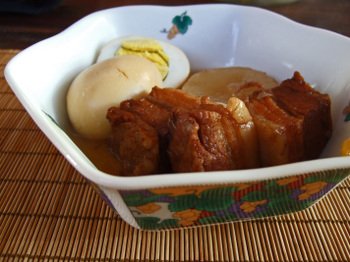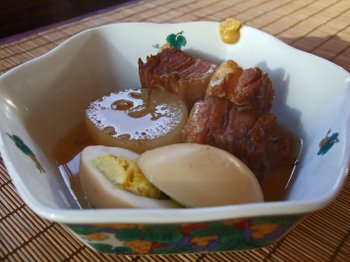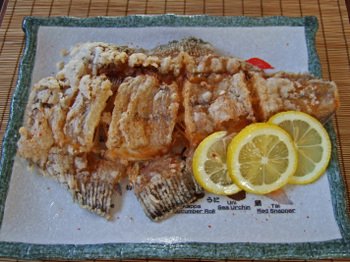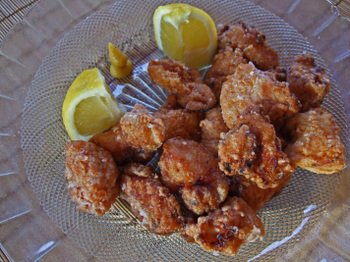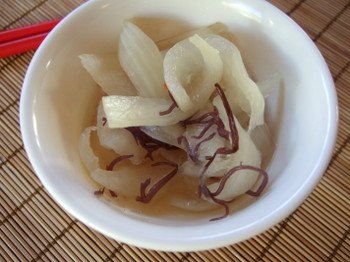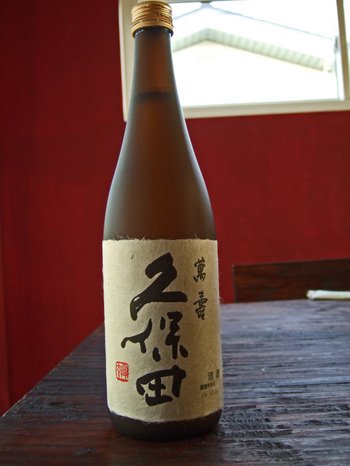*** I’ve had a few emails and several comments below asking about the origins of Buta Kakuni…best that I can tell is that Buta Kakuni is based on a Chinese Dish that the Japanese call Tonporo. Which to me means it’s probably Dong Po Rou(Dong Po Pork), if you follow the link, you’ll see that it looks very similar. Dong Po Rou is named after the poet Su Dong Po, you can see a translation of one of His poems here.
The other day, I was paging through a cookbook I had lying around titled The Japanese Kitchen, authored by Hiroko Shimbo. The recipe I just happened upon (lucky me!!!) was for Buta Kakuni, the Braised Pork dish that originated in Nagasaki Prefecture. Apparently, Buta Kakuni is based on a Chinese Pork dish, and Nagasaki was a busy port city where ships from all over the world docked. So somewhere between the sixteenth and eighteenth century Buta Kakuni arrived(lucky us!!!)……..
There are two Buta Kakuni recipes that I have used in the past. In the first recipe, the pork belly is first fried, than simmered for several hours. In the second recipe, the pork belly is first boiled in Okara(tofu lees) for several hours before a short braise in a sake-soy sauce-mirin-sugar liquid. What caught my attention was that Hiroko Shimbo’s recipe first steamed the pork belly, before cooking in the flavoring liquid. And what was even more interesting was that the pork belly was first covered with grated daikon! According to the book, Daikon contains two digestive enzymes, protease and diastase which help to remove excess fat and tenderize the pork belly.
What you see above is the result. I used the steaming technique in the book, but the flavoring is the one I’ve used before from other recipes. I’ve had some recipes from Hiroko Shimbo’s book not turn out really well. Since this was an experiment, I only used a 12oz portion of pork belly, which waaay more than enough for us! Buta Kakuni is pretty rich anyway, and I can only eat maybe 3 pieces….before the extreme remorse starts.
The Buta Kakuni Experiment
2 1/2- 3 Cups Grated Daikon(liquid and all)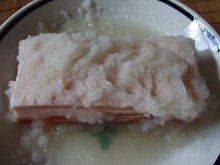
1 – 1 1/2 Lb Slab of Pork Belly
1/2 Tb (or more) Grated Ginger
1 1/2 Cup Water
1/2 Cup Sake
1/3 Cup Soy Sauce
1/3 Cup Sugar
4 Tb Mirin
1 – Set steamer over a pot of rapidly boiling water
2 – In a heatproof dish(make sure that it will fit the steamer) place 1/3 of the grated daikon and liquid over the bottom of the dish. Place the pork belly on top of grated daikon. Cover the pork with the remainder of grated daikon.
3 – Transfer dish to steamer and steam for 2 to 2 1/2 hours. I use a bamboo skewer after about 90 minutes to see how tender the pork belly is. Remember to keep replenishing the steaming liquid as necessary.
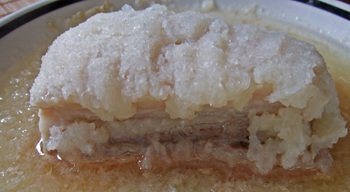
4 – Once the pork can be easily pierced with a bamboo skewer, remove the dish (carefully) from the steamer. Place the pork belly in a bowl of lukewarm water and gently rinse the pork.
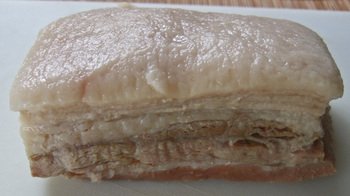
5 – Dry the pork with paper towels, and cut it into 2 inch cubes.
6 – In a pot large enough to hold the pork in a single payer mix together the rest of the ingredients. Place pork in pot and bring to a boil. Once boiling, reduce heat to a simmer.
7 – Simmer for 30 minutes, and check flavoring and texture. Make adjustments and simmer for at least 30 more minutes.
* On this day I added slices of daikon and boiled eggs before the last 30 minutes of simmering. Oh, and don’t forget the Hot Mustard!
The Pork Belly was very tender, and the remaining fat was smooth and velvety. The Missus thought it a bit too sweet, but I could have done with something cooked a bit longer, but I think the pork would have started falling apart. Of course, I’ve heard of places simmering their Buta Kakuni for 12 hours or more, but I don’t think I’ll be doing that in the near future.
Lest you think I was living on pork belly alone…..
I made the Missus some Karei Karaage:
And some Chicken Karaage:
And to cut the fatty flavors, some Pickled Onions with Ogo:
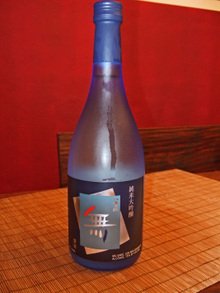 And followed it all with a double shot of Lipitor(I’m kidding, of course)! I did have a bit of one of my new favorite sakes, Yaegaki "Mu"…why they would name a sake "emptyness" is beyond me. This sake has a bit of a sweeter profile(not as sweet as Kurosawa), though I think it goes really well with food.
And followed it all with a double shot of Lipitor(I’m kidding, of course)! I did have a bit of one of my new favorite sakes, Yaegaki "Mu"…why they would name a sake "emptyness" is beyond me. This sake has a bit of a sweeter profile(not as sweet as Kurosawa), though I think it goes really well with food.
I did wish I still had another bottle of this on hand though!
